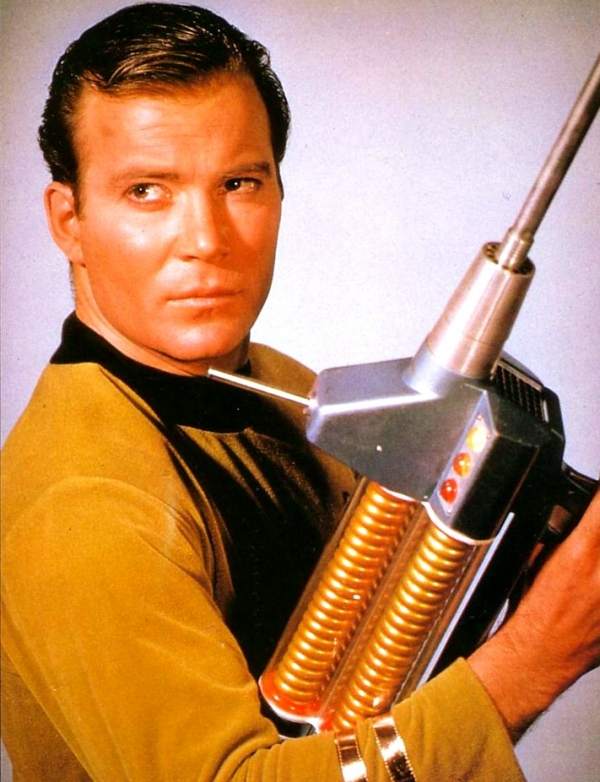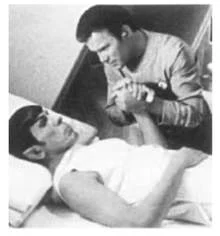Ship’s captains have been an important part of genre fiction for a long time. From the earliest recorded Greek epics to the most popular modern fiction, the captain of a ship has been the perfect character to illustrate leadership of a small band.
The captain does not have the power of a king, yet his power base shifts with him as the crew moves from adventure to adventure. Thusly, in our first genre feature series, we’re looking at ship’s captains, starting with the first captain that comes to mind for most geeks, James Tiberius Kirk.
D

uring the events of the original Star Trek series, James Kirk (played by William Shatner) captained the starship USS Enterprise.
Like many captains, Kirk was the principle character of the story, demanding that he do sometime un-captainly things to make sure that things got done the way they needed to be done.
Frequently he left the ship in the charge of one of the other members of his bridge crew in order to lead landing parties on his own, setting a precedent which would be followed by other captains of other Enterprises in the Star Trek to come.
Kirk was the most swashbuckling of the Enterprise captains, frequently engaging in combat personally, even hand-to-hand battles, and escaping from the most unlikely and deadly situations.
In literary terms, Kirk was close to anti-hero status. He was certainly rebellious, and ran the ship with a finely tuned gut instinct, which just as often lead him against regulations, as it led him with them.
His romantic life was a coming feature of many episodes, and this aspect of his life was almost absurdly tragic. Becoming involved with James Kirk was as dangerous as falling for James Bond. Though he seemed to love quickly, he loved truly, and was convinced on more than one occasion that he had found a soul mate.
Of course, every girlfriend was killed, captured, or some other way removed from the story by the end of each episode. It’s a wonder he did not completely give up on finding love.
Many of these girls were from alien species, however, and left the audience wondering about compatibility issues. Of course, the later revelation that, in the Star Trek universe, all of the bipedal sentient races have a very distant common ancestor helps a little.
Kirk’s support consisted mostly of two diametrically opposed characters. On his right was the stone-faced Mr. Spock, a Half-Vulcan Science officer who approached every issue with cold logic and an altruistic and practical philosophy.
On Kirk’s left was Doctor McCoy, a world-weary physician who came at issues from the standpoint of a man who has seen and known much of the human condition, bringing him at odds with Mr. Spock on almost every judgment.
Kirk would often listen to these two argue about any given situation before coming to his conclusion, which sometimes displeased both of them as illogical and unfeeling respectively.

Of course, Kirk’s ability to make decisions and solve problems was his strongest suit, and typically his luck bordered on the supernatural.
Kirk was later depicted, in the new Star Trek movie, as even more rebellious and intuition-centered resulting from a world in which he is orphaned young, and spends his entire youth getting in trouble on Earth, rather than being raised off-world, as in the original chronology. This new Kirk is also played by a new actor, Chris Pine.
One of the most interesting things about the character however happens outside the canon of the series. Way outside.
In the late 70s, there was a lot of Star Trek fan fiction flying around in the fanzines and small presses.
This group of writers was poised at just the right moment in history – after the beat generation’s free love movement, but before the homophobic AIDS scare – to generate the phenomenon of what we now call Slash Fiction, a genre of fan fiction which places two, usually heterosexual, characters from a popular fantasy property into a homosexual relationship.
The name comes from the subsets being described with a “/,” for example “Dean/Sam,” “Harry/Ron,” etc. It all started, however, with “Kirk/Spock.”
These, mostly female, fan fiction writers, saw a homoerotic element in the relationship between these characters, a certain dynamic which they felt could only be explained by sexual tension. The stories became popular amongst, mostly female, fans, and sparked off the enigmatic trend, which has, in recent years, been greatly strengthened and spurred by the Internet, as the authors are no longer required to publish in near obscurity.

Come back tomorrow when we will feature Captain Nemo of the Nautilus. If there is a ship’s captain which you would like to see featured in this series, let us know in the comments.






